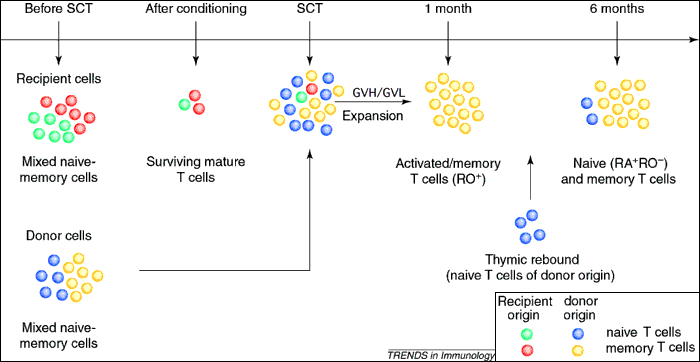Regeneration of T cell immunityThe restoration of a functional T cell compartment is much more cumbersome than that of the other hematological lineages. The bulk of the T cells are produced by the thymus around birth. During postnatal life, T cells that encounter antigen enter the memory pool, which increases the efficacy of the response against common (recurrent) pathogens. All this is destroyed by the conditioning regimens and the T cell immunity of the patient shortly after transplantation will depend on the few donor T cells that are co-infused with the stem cell graft. A new T cell repertoire will have to be reconstituted through the thymic pathway. Unfortunately, the thymic activity in adults is low. In addition, GVHD and its prophylaxis/treatment have a negative effect on T cell function as well as on the capacity of the thymus to produce new T cells. Two pathways to reconstitute the T cell poolDuring the first months after transplantation, the empty T cell compartment is rapidly repopulated through expansion of the few mature T cells co-transplanted with the graft. The number of T cells in the graft is much higher than the number of residual patient T cells that have survived the conditioning and usually all of the recipient T cells are eliminated. Thereafter, the number of T cells normalizes rapidly. Because the expansion of T cells is driven by antigen, most of the T cells will be specific for the the antigens encountered during the first months after transplantation such as histocompatibility antigens and viruses. As a consequence, most of the (other) T cell memory is lost and the patient, who may suffer from numerous infections, has to be revaccinated. The apparent contradiction between the rapid recovery of normal T cell numbers and the slow recovery of T cell immunity has been understood only recently. To date, it has been understood that once the T cell compartment has been restored by expansion, the loss of memory can only be restored through new T cell emerging from the thymus, which is the second pathway to reconstitute the T cell compartment. These new naive T cells appear about six month after transplantation. Still, this reconstitution is slow and the T cell compartment may remain unbalanced for many years with a reversed CD4/CD8 ratio and an incomplete T cell Receptor repertoire as major hallmarks. |
|
|
Transplantation Immunology | |||||||||||||||||||
|
||||||||||||||||||||



 Print
Print